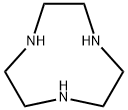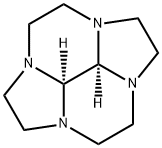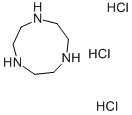1,4,7-Triazacyclononane
Synonym(s):Octahydro-1H-1,4,7-triazonine;Triethylenetriamine
- CAS NO.:4730-54-5
- Empirical Formula: C6H15N3
- Molecular Weight: 129.2
- MDL number: MFCD00012358
- EINECS: 637-157-5
- SAFETY DATA SHEET (SDS)
- Update Date: 2025-07-24 18:13:44

What is 1,4,7-Triazacyclononane?
Description
1,4,7-Triazacyclononane, known as "TACN" which is pronounced "tack-en," is a cyclic organic compound with the formula C6H12(NH)3. TACN is derived, formally speaking, from cyclononane by replacing three equidistant CH2 groups with NH groups. TACN is one of the oligomers derived from aziridine, C2H4NH. Other members of the series include diazacyclohexane, C4H8(NH)2, and the cyclic tetramer 1,4,7,10-tetraazacyclododecane.
Chemical properties
White - light yellow solid
The Uses of 1,4,7-Triazacyclononane
1,4,7-Triazacyclononane (TACN) is a versatile platform from which various ligands can be derived to form effective chelators for (radio)copper(II) complexation. The ability of TACN-derivatives to form highly stable complexes with copper(II) is greatly influenced by the number and type of substituents on the macrocyclic ring. The formed copper(II) complexes show a broad variability in their thermodynamic stability and kinetic inertness, varying in structure from square-pyramidal to distorted octahedral. TACN-based BFCAs have also been used for indirect radiolabelling of biomolecules, rendering them suitable for imaging and therapy.
The Uses of 1,4,7-Triazacyclononane
Starting material for the synthesis of 1,4,7-trifunctionalized derivatives which have applications in metal complexation.
What are the applications of Application
1,4,7-Triazacyclononane is a possible reagent for compleximetric titrations with high cation-binding selectivity
Preparation
The ligand is prepared from diethylene triamine as follows by macrocyclization using ethyleneglycol ditosylate.
H2NCH2CH2NHCH2CH2NH2 + 3 TsCl → Ts(H)NCH2CH2N(Ts)CH2CHH2N(H)Ts + 3 HCl Ts(H)NCH2CH2N(Ts)CH2CH2N(H)Ts + 2 NaOEt → Ts(Na)NCH2CH2N(Ts)CH2CH2N(Na)Ts Ts(Na)NCHH2CH2N(Ts)CH2CH2N(Na)Ts + TsOCH2CH2OTs + → [(CH2CH2N(Ts)]3 + 2 NaOTs [(CH2CH2N(Ts)]3 + 3 H2O → [CH2CH2NH]3 + 3 HOTs
What are the applications of Application
Starting material for the synthesis of 1,4,7-trifunctionalized derivatives which have applications in metal complexation.
Possible reagent for compleximetric titrations with high cation-binding selectivity.
Definition
ChEBI: 1,4,7-triazonane is a saturated organic heteromonocyclic parent, a crown amine and an azacycloalkane.
Properties of 1,4,7-Triazacyclononane
| Melting point: | 42-45 °C (lit.) |
| Boiling point: | 110-130 °C/7 mmHg (lit.) |
| Density | 0.9987 (rough estimate) |
| refractive index | 1.4620 (estimate) |
| Flash point: | >230 °F |
| storage temp. | 2-8°C |
| Water Solubility | Soluble in water |
| solubility | Chloroform (Slightly), Methanol (Slightly) |
| pka | 10.57±0.20(Predicted) |
| form | crystal |
| color | white |
| BRN | 773877 |
Safety information for 1,4,7-Triazacyclononane
| Signal word | Danger |
| Pictogram(s) |
 Corrosion Corrosives GHS05 |
| GHS Hazard Statements |
H314:Skin corrosion/irritation |
| Precautionary Statement Codes |
P260:Do not breathe dust/fume/gas/mist/vapours/spray. P280:Wear protective gloves/protective clothing/eye protection/face protection. P363:Wash contaminated clothing before reuse. P303+P361+P353:IF ON SKIN (or hair): Remove/Take off Immediately all contaminated clothing. Rinse SKIN with water/shower. P305+P351+P338:IF IN EYES: Rinse cautiously with water for several minutes. Remove contact lenses, if present and easy to do. Continuerinsing. |
Computed Descriptors for 1,4,7-Triazacyclononane
| InChIKey | ITWBWJFEJCHKSN-UHFFFAOYSA-N |
1,4,7-Triazacyclononane manufacturer
New Products
4,4-Difluoropiperidine hydrochloride tert-butyl 9-methoxy-3-azaspiro[5.5]undecane-3-carboxylate Indole Methyl Resin N-Isopropylurea N,N-Dicyclohexylcarbodiimide(DCC) MELDRUMS ACID 5-METHYLISOXAZOLE-4-CARBOXYLIC ACID Magnessium Bis glycinate Zinc ascorbate 1-bromo-2-butyne 2-acetamidophenol 9(10H)-anthracenone Erythrosin B, 4-Piperidinopiperidine 2-((4-morpholinophenylamino) (methylthio) methylene) malononitrile 2,4-dihydroxybenzaldehyde 3-(4-morpholinophenylamino)-5-amino-1H-pyrazole-4-carbonitrile Methyl 2-methylquinoline-6-carboxylate 2,6-dichloro-4-nitropyridine 4-Bromo-2-chlorobenzonitrile 2-(benzylamino)acetic acid hydrochloride 4-(tert-Butoxycarbonylamino)but- 2-ynoic acid 3,4-dihydro-2H-benzo[b][1,4]dioxepine 1-Phenyl-1-cycloprppanecarboxylicacidRelated products of tetrahydrofuran







![DODECAHYDRO-3H,7BH-2A,5,5B,7A,10,10B-HEXAAZACYCLOPENTA[HI]ACEANTHRYLENE](https://img.chemicalbook.in/StructureFile/ChemBookStructure3/GIF/CB9779378.gif)
You may like
-
 Triethylene Triamine CASView Details
Triethylene Triamine CASView Details -
 Triethylene Triamine CASView Details
Triethylene Triamine CASView Details -
 1,4,7-Triazacyclononane CAS 4730-54-5View Details
1,4,7-Triazacyclononane CAS 4730-54-5View Details
4730-54-5 -
 1,4,7-Triazacyclononane CAS 4730-54-5View Details
1,4,7-Triazacyclononane CAS 4730-54-5View Details
4730-54-5 -
 3-(4-amino-1-oxoisoindolin-2-yl)-1-methylpiperidine-2,6-dione 98%View Details
3-(4-amino-1-oxoisoindolin-2-yl)-1-methylpiperidine-2,6-dione 98%View Details -
 20677-73-0 (2,2-diethoxyethyl)methylamine 98%View Details
20677-73-0 (2,2-diethoxyethyl)methylamine 98%View Details
20677-73-0 -
 3-(4-(hydroxyamino)-1-oxoisoindolin-2-yl)piperidine-2,6-dione 98%View Details
3-(4-(hydroxyamino)-1-oxoisoindolin-2-yl)piperidine-2,6-dione 98%View Details -
 57381-49-4 2-bromo-4-chlorobenzonitrile 98%View Details
57381-49-4 2-bromo-4-chlorobenzonitrile 98%View Details
57381-49-4
